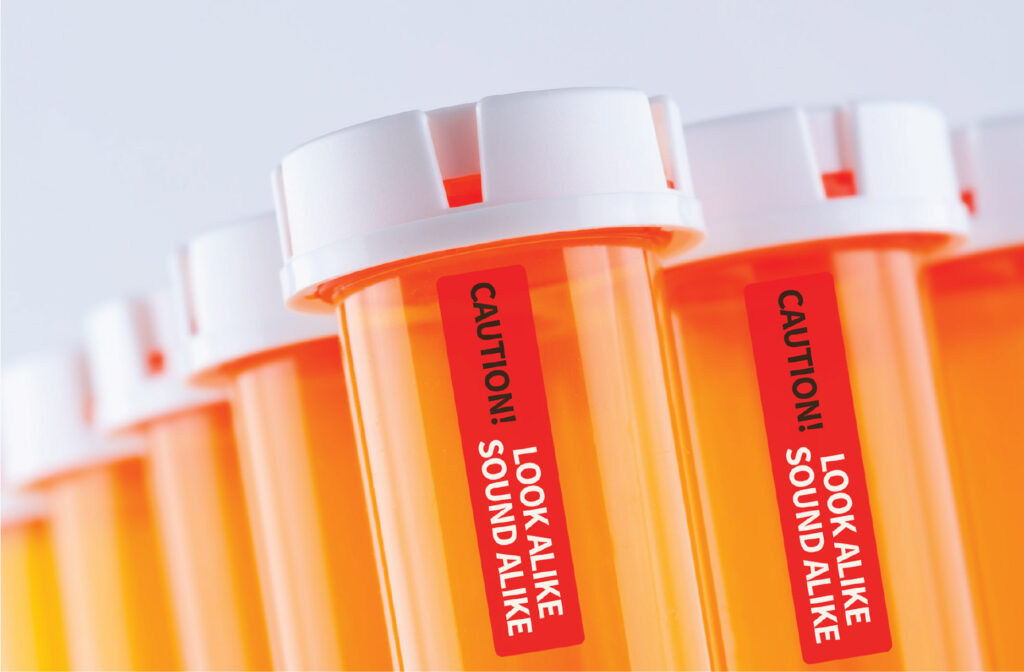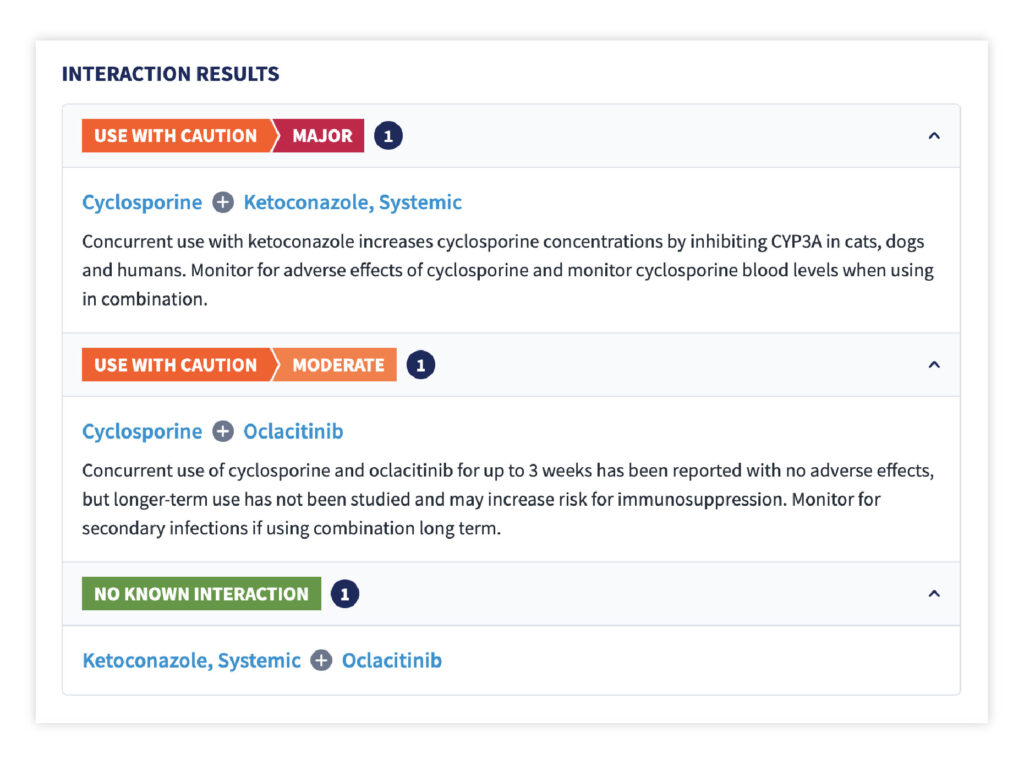You’re hurrying to your next appointment when an upset team member pulls you aside to tell you they accidentally administered the wrong dose of medication to a patient. Or you’re reviewing records and realize you’ve accidentally given the wrong drug or dose to a patient yourself. The realization that a mistake has been made—and the surge of anxiety it brings—doesn’t get easier. And unfortunately, no matter how experienced we are or how much we care about our patients, medication errors happen.
Studies have shown that medical errors may occur in approximately 5 out of every 1000 veterinary medical visits, and of these, medication errors appear to be one of the most common causes, accounting for between 55% and 69% of all reported errors in veterinary medicine.1
Thankfully, there are some simple steps we can take to reduce the risk and help safeguard our patients against medication errors.
Here are 5 tips to reduce common medication mistakes in veterinary practice.
1. Watch Out for Sound-Alike and Look-Alike Drugs
We’ve all been there. We leave the exam room, snag our nearest technician, tell them what medications we’d like them to fill or draw up for our patient, and get started on our next appointment.
But verbally relaying medication information can leave room for misinterpretation, especially when it comes to drugs with names we commonly abbreviate, like “dex.”
Sound-alike drugs can also be an issue. Whether drugs are typically referred to by their trade names or generic names, watch out for sound-alikes such as Cerenia® (maropitant citrate) and Convenia® (cefovecin sodium), azathioprine and azithromycin, or hydroxyzine and hydralazine.
Some drugs are packaged very similarly, and these look-alike drugs can make it easy to grab the wrong drug off the shelf accidentally.
The best way to prevent mistakes with look-alike and sound-alike drugs is to always use written instructions and full names when spelling out drugs. Tall man lettering—uppercase lettering that helps differentiate look-alike drug names (eg, hyDROXYzine vs. hyDRALAzine)—can also be beneficial.
Consider storing drugs with similar names or packaging on different shelves and adding “look-alike” or “sound-alike” alert labels to the packaging, so the person filling the prescription is prompted to double-check they have the right drug.

2. Avoid Abbreviations and Review Your Zeros on Prescriptions
Writing out the full names of drugs and using tall man lettering can help prevent errors with written prescriptions, but there are additional steps you can take to minimize mistakes.
Computerized prescription labels can prevent misreading handwriting, and putting as much information as you can on the prescription—even if it feels like too much—can also be beneficial.
Avoid writing in shorthand or abbreviations, especially as some abbreviations can be easy to misread. For example, SID (once per day) can be misread as 4 or 5 times a day, and IU as IV. It’s easy to mistake QOD (every other day) for QD (every day) or QID (4 times a day), so writing out full instructions such as “daily” or “every other day” is key.
Ensure you always use a leading zero when writing a dose (ie, 0.1 mg, never .1) and avoid use a trailing zero (ie, 1 mg, not 1.0 mg) to prevent incorrect dosing if the decimal point is missed.
If it’s absolutely necessary to give a prescription verbally in the clinic or over the phone, always have your technician or a pharmacist repeat the information back to you to ensure it’s correct.
3. Use an Interaction Checker to Identify Concerning Drug Interactions
As our patients age and our treatment arsenal grows, so does the number of patients we see on multiple medications.
In human medicine, studies have shown that increasing the number of medications a patient is on increases the risk of undesirable reactions exponentially. The probability of an adverse drug interaction was 13% with 2 drugs, and this rose to 58% with 5 medications and 82% when a patient was on 7 or more medications.2
Double-checking for drug interactions before you prescribe is an important step in decreasing medication errors in practice and keeping your patients safe.
Unfortunately, human-specific drug interaction checkers don’t take species-specific information into account, and the results can leave dangerous information gaps due to differences in sensitivity to drugs, drug-metabolizing enzymes, and elimination pathways between animals and humans.3
However, the drug interaction checker in Plumb’s™ contains animal-specific information based on current evidence and is continually reviewed by veterinarians and veterinary pharmacists, so it can help you make confident treatment decisions for your patients.

4. Minimize Distractions When Handling Veterinary Drugs
You’re in the middle of counting pills when you’re asked a question or distracted by an incoming patient. Inevitably, you lose count and have to start all over again. It’s happened to all of us.
It’s no surprise that mistakes are more likely to happen when we’re distracted, and studies in human medicine have confirmed that the risk and severity of medication administration errors increase as the frequency of interruptions increases.4
Human medical practices are trying various strategies to combat distractions, including having staff wear high-visibility attire when handling or filling medications or instituting “No Interruption Zones” where staff can handle drugs without distraction.5,6
Adopting a policy that team members are not to be interrupted when handling medications or creating a designated quiet area in your clinic for staff to fill medications may help reduce the risk of medication errors.
5. Follow the Five Rights of Medication Administration
It’s standard for human healthcare practitioners to verify the “five rights” or “five Rs” of medication administration before a drug is given or prescribed7:
- Right patient
- Right drug
- Right route
- Right time
- Right dose
Ensuring veterinary team members verify this information with a second team member every time a medication is dispensed may reduce the chance of errors in veterinary practice.
Adopting a policy of triple-checking can also help minimize errors. When a team member is dispensing or administering a drug, the vial or bottle should be verified against the information on the prescription label or treatment sheet 3 times:
- When the drug is removed from the shelf
- When it is drawn up or counted
- Before it is administered to the patient or dispensed to the pet owner
Placing a list of the five Rs and a reminder to triple-check prescriptions in your pharmacy can act as a visual reminder to complete these steps and help prevent errors.
We’re only human, and no matter how experienced or careful we are, we all face the potential for errors every time we prescribe. But following these simple steps can help minimize the risks and keep our patients safe.
Having access to a trusted source of accurate and continually updated drug information is also crucial, and features like the Plumb’s™ drug interaction checker can give you additional support when you prescribe.
Already subscribed to Plumb’s™? Try the interaction checker.
Think you could use Plumb’s™ and the drug interaction checker in your practice? Choose your Plumb’s™ plan today.
References
- Wallis J, Fletcher D, Bentley A, Ludders J. Medical errors cause harm in veterinary hospitals. Front Vet Sci. 2019;6:12.
- Goldberg RM, Mabee J, Chan L, Wong S. Drug-drug and drug-disease interactions in the ED: analysis of a high-risk population. Am J Emerg Med. 1996;14(5):447-450.
- Boonyarattanasoonthorn T, Khemawoot P, Kijtawornrat A. Comparing potential drug-drug interactions in companion animal medications using two electronic databases. Vet Sci. 2021;8(4):60.
- Westbrook JI, Woods A, Rob MI, Dunsmuir WT, Day RO. Association of interruptions with an increased risk and severity of medication administration errors. Arch Intern Med. 2010;170(8):683-690.
- Anthony K, Wiencek C, Bauer C, Daly B, Anthony MK. No interruptions please: impact of a No Interruption Zone on medication safety in intensive care units. Crit Care Nurse. 2010;30(3):21-29.
- Westbrook JI, Li L, Hooper TD, Raban MZ, Middleton S, Lehnbom EC. Effectiveness of a ‘Do not interrupt’ bundled intervention to reduce interruptions during medication administration: a cluster randomised controlled feasibility study. BMJ Qual Saf. 2017;26(9):734-742.
- Hanson A, Haddad LM. Nursing Rights of Medication Administration. In: StatPearls. Treasure Island (FL): StatPearls Publishing; September 4, 2023.


